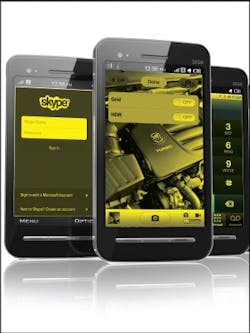Every day in his Newark, Del., shop, Pete Rudloff sees the technological gap in the industry.
Pete’s Garage Inc. prides itself on being the shop that fixes the “unfixable problems.” That means facilities from all around New England—upwards of 40 shops in all, Rudloff says—send their problem cases to Pete’s.
“Usually, it’s things they should be able to fix,” Rudloff says. “They’re just behind. They’re fixing cars like it’s 1995, and they don’t have the scan tools, equipment or technology in the shop to fix things correctly.
“Technology-wise, as a trade, we’re starting to get passed by.”
It can’t be that way, though, Rudloff says. For shops to thrive in the modern industry, they can’t keep their heads in the sand—or under hoods—with blinders to the technological advances that other industries are embracing. It’s time to start pushing the industry forward.
“We can’t keep playing catch-up,” he says. “We can’t predict the future, but we can try to see what’s coming down the road and start making adjustments. There are big things happening all the time, and we need to be on top of it.”
Big ideas can come from anywhere, inside or outside the industry. Ratchet+Wrench identified three major technological advances that will soon affect the way you work, if they haven’t already.
Telematics: A New Age of Information
Bret Tobey says to picture this situation: A regular customer of your shop keeps seeing her vehicle’s check engine light intermittently going on and off. She goes to the store, and it’s on. She leaves, and it’s off. She drives to work the next morning, and it’s on again.
“Ideally, this customer is going to go, ‘Oh, there’s the light. I’ve got to bring my car in,” Tobey says. “But, in actuality, they’re more likely to drive around like that for days before calling you, right?”
Tobey says to imagine that while the customer drives around avoiding the inevitable trip to your shop, you already received notification that the light went on, complete with the problem codes to explain the vehicle’s issue.
“Now, you can call them up and say, ‘This is what we’re seeing. You’re going to need to bring it in,’” Tobey says. “That’s the future.”
And that’s where companies like Carvoyant (carvoyant.com), which Tobey founded with Renz Kuipers and Matt Galvin in mid-2011, and Delphi want to take industry telematics.
Scott Luckett, chief information officer for the Automotive Aftermarket Association, gave a presentation on the subject at a recent Equipment & Tools Institute event. While telematics technology includes many consumer-focused products, such as navigation systems, Luckett says the technology’s largest power, when it comes to the repair industry, lies in the information it can obtain from the vehicles.
Both Carvoyant and Delphi produce a hardware device that, most commonly, plugs into a vehicle’s OBD-II port. (Currently, more than 160 million vehicles in the U.S. accept OBD-II plug-ins, according to Luckett.) The device then reads information about the car, and sends the data directly back to the company, i.e. Carvoyant or Delphi. The company then sends it back to the driver in the form of a text or email, or in Delphi’s case, posts it to a Web-based platform.
Updates may include when certain service milestones are met for the vehicle, or when a check engine light code registers in the system.
“The whole goal,” Tobey says, “is to put this information in the hands of customers so they can make informed decisions and get their cars in the hands of someone who knows how to fix it.”
That last part is where this truly benefits the repair industry, says Tom Piippo, who volunteered his shop, Tri-County Motors in Rudyard, Mich., as a beta test site for the initial version of the product. Carvoyant gives the customers control of their data: what updates they receive, how often, and whom this information is shared with.
Customers can choose to have all of their information (or certain aspects of it) routed directly to their local repair shop. With Carvoyant, the shops can also pay a minimal monthly “sponsorship” fee (normally just a dollar or two, Tobey says), which goes to cutting down the customer’s subscription costs. This allows them to send promotional messages to the customer.
“It’s a different way to communicate with customers and with their vehicles,” Piippo says.
App Store
There are many mobile applications that, when downloaded to your smartphone, can help in your shop. Shop owners Pete Rudloff and Tom Piippo identified three of their most-used.
WORLDPAC VIN Scanner (worldpac.com/app)
What it is: Scans vehicle identification numbers and provides quick, accurate and brief vehicle information. Data is also sent directly to your shop’s front desk.
Cost: Free
Benefit: Streamlines the look-up process, Piippo says, especially when technicians need to identify parts.
Gates Parts Image Capture (PIC) Gauge
(gatesprograms.com)
What it is: Measures and evaluates serpentine belt wear.
Cost: Free
Benefit: Piippo says it gives very accurate readings and can help take some guess work out of the process.
GoToMyPC
(gotomypc.com)
What it is: Allows remote access to all files on your desktop computer.
Cost: $9.99 per month subscription with a 30-day free trial.
Benefit: Piippo uses it to keep an eye on his business while away from the shop.
Skype
(skype.com)
What it is: Allows video calling to other Skype users.
Cost: Free
Benefit: Rudloff has used it to describe vehicle issues to customers, and answer questions from his technicians while out of the shop.
Talking Cars
James Sayer is a research scientist with the University of Michigan Transportation Research Institute (UMTRI). He has a Ph.D. in industrial and systems engineering, and has contributed to the development, evaluation and deployment of adaptive cruise control, collision warning and collision avoidance systems. Currently, he is the lead researcher in UMTRI’s Connected Vehicle Safety Pilot Model Deployment program, a study sponsored by the U.S. Department of Transportation that is evaluating vehicle-to-vehicle communication technology in some 3,000 test vehicles. Sayer spoke with R+W about the emergence of this new technology and its significance for the auto care industry.
R+W: Can you describe vehicle-to-vehicle communication?
Sayer: Basically, what vehicles are doing is transmitting very simple information—their latitude, their longitude, their speed and their heading. They’re broadcasting that to vehicles around them, and other vehicles are doing the same. In theory, if you knew where all vehicles were, and you knew how fast and in what direction they were traveling, you could predict their trajectory and warn a driver that his or her vehicle is going to potentially collide with another.
R+W: How will this technology affect the service and repair industry?
Sayer: In theory, as with other technology like [adaptive cruise control (ACC)], vehicles are going to get safer, and that means fewer crashes and fewer issues to fix.
—James Sayer, University of Michigan Transportation Research Institute
Then there is the aspect of installation and maintenance. We are installing it into cars, trucks, motorcycles, buses—everything. It normally takes only about an hour and 15 minutes to do, and that’s with temporary installations where we can’t drill any holes into the vehicles. The device, besides needing power and cabling, needs two antennas—a GPS antenna and a wireless antenna to receive signals [from other vehicles]. Then the device itself is installed into the vehicle, normally though the OBD-II port or via the existing fuse box.
It’s likely that repair facilities will need to learn the installation process, and have a strong enough understanding of the system to be able to assist when the system has issues.
Really, all manufacturers are regularly improving their technology in vehicles. We have eight involved in our study (Ford, General Motors, Nissan, Volkswagen, Mercedes-Benz, Honda, Audi and Hyundai and its affiliate Kia). There are automotive manufacturers that are talking about, in the next five years, having additional levels of automation available in cars that are completely independent of connected-vehicle technology. Those might be things like lane-keeping assistance or stop-and-go ACC.
The question then becomes, what are those in the repair industry going to do to be ready for that? This is the direction vehicles are going, and everyone across the entire auto industry needs to be prepared.
Smartphones, Smart Work
The phone sat in a drawer in his kitchen for several weeks. It was his wife’s first iPhone, and after she upgraded to a newer model, it took Piippo quite a while before he finally caved in and decided to put the discarded smartphone to use.
“Why not?” says Piippo. “I wasn’t sure what I would use it for, but I figured I could try to get some use out of it. Now, I can’t believe I ever worked without it.”
The fact is, smartphones may be the single most undervalued piece of equipment in the repair industry, Piippo says. He certainly underestimated its usefulness—initially, at least—but he now suggests that all facilities try to integrate the many uses of mobile devices into their daily routines.
—Pete Rudloff, owner, Pete’s Garage
Rudloff purchases smartphones for every full-time employee at Pete’s Garage, having paid the phone bills of as many as eight people at one time.
“I just think it’s that important,” he says. “There are so many things that we use it for. It really changed the way we do things.”
Efficient, convenient and affordable, smartphones can have a positive impact on every aspect of your business.
Phone Calls. In their simplest form, smartphones are still telephones. For Rudloff, they’ve changed the way his shop handles the phone.
His shop’s main line rings through to his mobile device if for any reason it goes unanswered at the front desk. And simply opting to answer through his smartphone allows him mobility throughout the shop.
It also helps with contact storage: In addition to keeping customer phone numbers and emails in the shop database, Rudloff also stores it on his mobile device, making it easier to reach customers while on road tests or back in the bays.
Photographs and Videos. First it was Polaroids, then digital cameras, and now, Rudloff and his staff use their phones to document repairs with photos.
“They’re high-quality pictures, and it takes no time at all to email it or text it to the customer, or a warranty company, or even my technician,” he says.
Piippo agrees, and he also has technicians use it to help with reassembly: “If you’re doing a dash job, and the wire connectors are similar but different, you can just take pictures as you go,” he says. “Then, when you’re done, you delete them and go on to the next job.”
Both Piippo and Rudloff have also used video recording on their phones to walk through an issue with a customer. Once done recording, they simply send it on to the customer, either through text message or email.
Other Uses. Rudloff uses Google calendars for his shop’s scheduling, and it can be accessed and updated through his shop’s phones. The phones also come in handy to look up repair data, or even access information service providers like ALLDATA and Mitchell1.
About the Author

Bryce Evans
Bryce Evans is the vice president of content at 10 Missions Media, overseeing an award-winning team that produces FenderBender, Ratchet+Wrench and NOLN.
